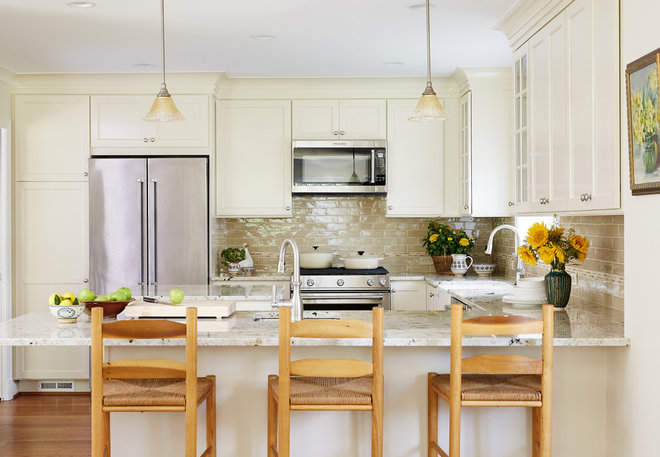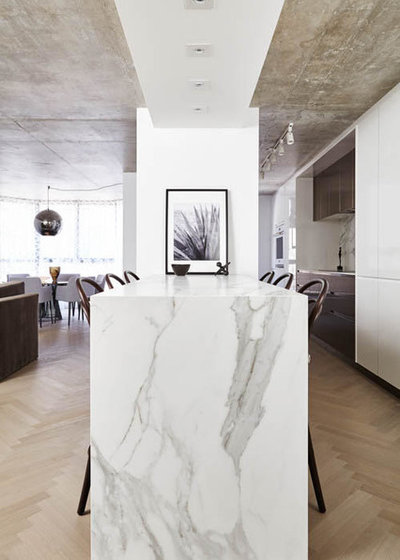These days there are countless materials available for kitchen benchtops. But instead of giving you the pros and cons of each material (you can read about
different benchtop materials here), let’s break down six popular colour families so you can achieve the look you want with the material that suits your needs.
1. Flecked or softly veined white benchtops
One of the most common and coveted benchtop finishes is a stone or manufactured slab material, such as quartz, in a white or off-white shade with a light multi-tonal fleck or grain to give it subtle natural richness.This snowy, sparkling look works well in many situations as it is very neutral but also contemporary and fresh. The pale tone brings a sense of cleanness and lightness to the space with a twist of subtle sophistication.
In more traditional kitchens, this is usually a better choice than a true minimalist white benchtop, which can be too severe and fight with the elegance of other elements, such as knotty timbers,
Shaker cabinets or statement pendant lights.
Flecked or softly veined white benchtops are good for you if:
- You have a traditional or transitional interior.
- You want the space to look big and light without feeling clinical.
- You want white benchtops but don’t want every crumb and speck of dust to show.
2. Pure white benchtops
Pure white benchtops, generally only available in manufactured materials such as
Corianor
Caesarstone, bring a contemporary, minimalist freshness that no natural stone can match. Luckily, these materials resist stains well, so they can stay a crisp white for years with just a little care.
This stark look works well in contemporary spaces. The severity of a true white can sometimes fight with traditional decor, but in a modern space it feels appropriately crisp. It’s especially effective in small spaces, such as urban apartments and compact kitchens,paired with minimalist white cabinets to give the illusion of a bigger space.
In this example, the benchtops are paired with a more sumptuous backsplash to balance the stark white with a little gentle character.
Here is another use for white benchtops: spaces that already have a great deal of bold character in the other finishes, such as grainy timber cabinets, can benefit from a simple benchtop as a visual break.
This is especially true for modern flat-fronted cabinets in a timber finish with a yellow-orange undertone. A pure white benchtop will keep the look feeling fresh and contemporary instead of retro.
Lastly, white and blue is a classic nautical combination, so while off-white would also work, a pure-white benchtop looks beautiful paired with blue-painted cabinetry. Despite both being chilly colours, the two together feel welcoming and always stylish.
Browse more blue-and-white kitchens
Pure white benchtops are good for you if:
- You love crisp, modern style.
- You have a small space that you want to look as big as possible.
- You want to break up modern timber cabinets or other bold finishes.
- You love a nautical white-and-blue scheme.
3. Timber benchtops
Warm wood, with its inviting air and natural richness, is a great choice for infusing a cool, breezy kitchen with some approachable character. Crisp
white kitchens can feel a little more liveable and a tad less austere with timber benchtops. It makes a popular choice for transitional kitchens that balance traditional and contemporary elements, especially as classic timber fits into both categories.
Notice in several of these examples how timber only dresses the island benchtops. Wood in general is an excellent material to use for an accent benchtop (often on a kitchen island or a small chopping zone in the form of a butcher’s block), contrasting with nearby stone or solid-surface benchtops in a pleasing way.
Lighter timbers tend to have more of a casual or rustic feel compared with dark-stained options. Light-stained or unstained woods can have a cottage-inspired feel or a Scandinavian vibe, depending on whether you pair them with traditional or modern accoutrements. In either case, a traditional runner rug – or in the case of this kitchen, a tiled runner – makes an excellent complement.
Browse stylish, Scandinavian-style kitchens
Darker timbers come off a little more formal and polished than lighter tones. They lend a certain gravity to a space, which can work well in areas that are already bright and breezy with lots of windows.
When mixing timber benchtops with other wood finishes, it’s often best to stick to either warm or cool tones across the board. Red-brown timbers are more traditional, while ashy and grey tones have been a popular trend in recent years. Whichever tones you prefer, they will be less likely to clash if you stick to one colour family or the other.
Timber benchtops are good for you if:
- You want an accent benchtop to contrast with other surfaces.
- Your white cabinets need a little warming up.
- You want your space to feel more approachable and intimate.
- You enjoy a dash of rustic charm.
- You can’t get enough of timber.
4. Dark or black benchtops
Dark benchtops, in tones such as black or charcoal, can appear very gothic in some situations and perfectly harmonious in others. If you have dark cabinetry, dark floors or other rich and weighty finishes, a dark benchtop will fit right in. In this example, you can see that the white benchtop is the one that pops, compared with the island bench, which almost blends into the deep-hued timber drawer fronts.
If you’re going for a dark-on-dark palette, it helps to have lots of
light sources in your kitchen – natural, added or both. This will keep the space feeling cosy and sophisticated instead of cave-like.
Because white can sometimes absorb and dampen nearby colours, a rich, dark benchtop is often the better choice to bring out subtle colours in painted cabinets, such as the powder-blue door units in this kitchen.
Choosing a dark grey rather than pure black will soften the look, so it’s usually preferable to stop at charcoal in most situations.
Here’s an eat-in kitchen where dark benchtops are almost a must. When you’re using a tinted mirror backsplash to subtly open up the space visually, a dark benchtop will echo the deep, moody surface for a perfect complement.
In this kitchen, the benchtop picks up on the black elements of the appliances, the dark legs of the furniture and the rich and complex parquet floors, so it feels integrated into the design rather than being a single exclamation point.
Lastly, sometimes you just want that classic black-and-white look. If you have a kitchen with crisp white cabinets and little actual colour, or you have just a few small areas of benchtop, a dark or black stone brings some instant drama.
Again, it’s never wise to have just one large black element in your design as it may stand out like a sore thumb, so you’ll want to introduce other sprinklings of black such as elegantly simple black cabinet knobs and pulls.
Browse beautiful, crisp white kitchens
Dark or black benchtops are good for you if:
- You have dark cabinets and want the benchtops to blend in with them.
- You have colourful, fun cabinets, and you want the hue to really shine.
- You have a smoky mirrored backsplash, a trendy favourite in apartments and modern homes.
- You want to connect to other black elements in the space.
- You’re aiming to achieve a classic black-and-white kitchen scheme.
5. Mid-tone or grey benchtops
Soft-grey benchtops and other mid-tone shades, such as beiges or rich creams, are the most neutral benchtop options. In this kitchen – with its creamy off-white cabinets and golden-yellow undertones in the splashback and timber – the dreamy, creamy benchtops add to a harmonious look, perfect for casual family breakfasts.
Softly flecked grey stone can look similar to concrete, and it works perfectly in contemporary spaces with a bit of an architectural bent. It has the advantage of hiding the occasional spot while still looking clean and tidy and not too dark or busy. It’s great if you don’t always have a perfectly organised space but still want a put-together look.
If you have a black-and-white scheme, or espresso woods with white walls, and you want to soften the whole look, a mid-tone benchtop will bridge the very dark and very light elements and help them meet in the middle.
9 Kitchen Colours You Won’t Tire Of
Grey is also a beautiful tone to pair with warm
metallic accents.If you love a brassy faucet or basin, a grey benchtop will bring out those warm tones so they really shine.
Mid-tone or grey benchtops are good for you if:
- You want a soft, friendly vibe with harmonising, muted tones.
- You have colourful cabinetry or multiple tones of cabinets mixed together.
- You have a black-and-white scheme that could use a little softening.
- You love warm metallic accents and want to show them off.
6. Dramatic benchtops
Boldly veined stone benchtops can either make you stop and gaze in admiration or have the opposite effect and overwhelm your eyes.
In general, the bolder the veining on your counters, the less drama you’ll want to add elsewhere. This waterfall benchtop (with the material wrapped down the sides) is relatively muted, but the large grey veins still bring enough character without any daring colours or other statement features.
Everything You Need to Know About Benchtop Profiles
The size of your space will be a factor in determining just how dramatic a bold stone looks once it’s installed. In this vast kitchen, the scale of the dining island extension suits the space perfectly.
This isn’t to say you can’t use a bold stone in a
compact kitchen, just that it will feel even more dramatic in scale, meaning you probably will want to keep the other finishes somewhat sedate. Notice how many of these spaces use the same dramatic stone for the benchtop and splashback, making for a truly singular statement.
A dark, richly veined stone can actually feel less dramatic when paired with dark cabinets. Whether you use espresso-hued timber or a modern painted grey, as shown in the previous photo, coordinating a base tone in the stone with one of a similar darkness or lightness in the cabinets will help the two connect.
Ultimately, the only way to tell how a richly veined stone will look with your other elements is to bring home the largest sample you can or take samples of your other elements to the dealer to see what tones are strongest in the stone.
Dramatic benchtops are good for you if:
- You have a large kitchen.
- You want the benchtops to be the primary statement.
- You have dark cabinets to offset a dark, moody stone.
- You can’t get enough visual drama.
Sourced: www.houzz.com.au



































